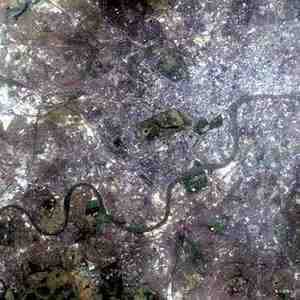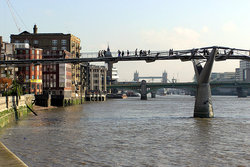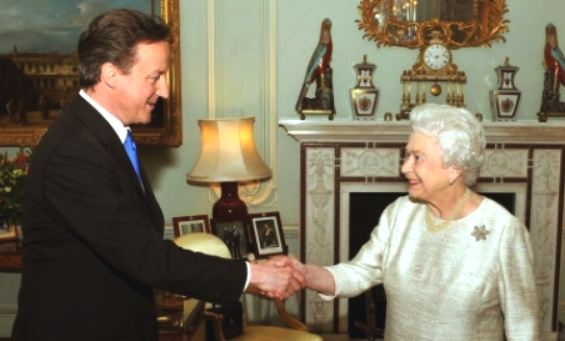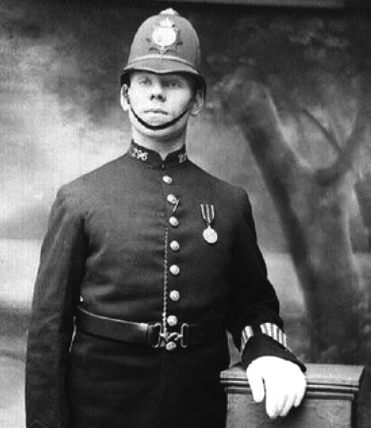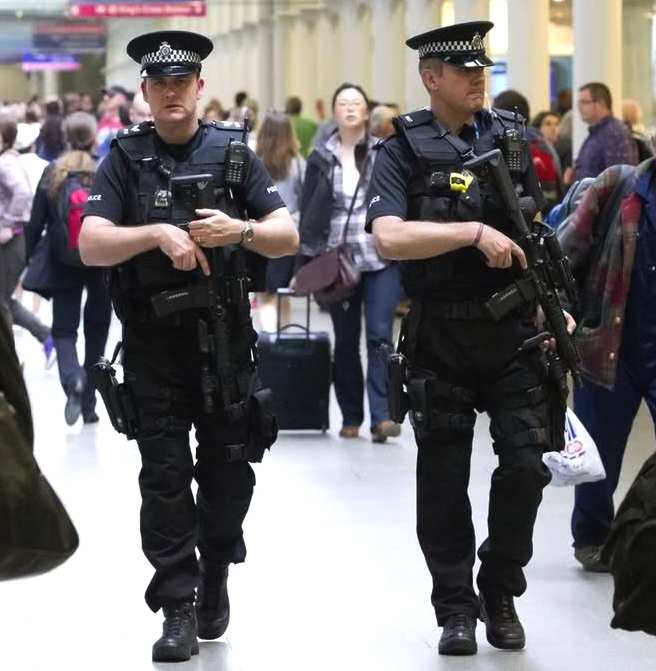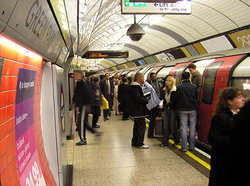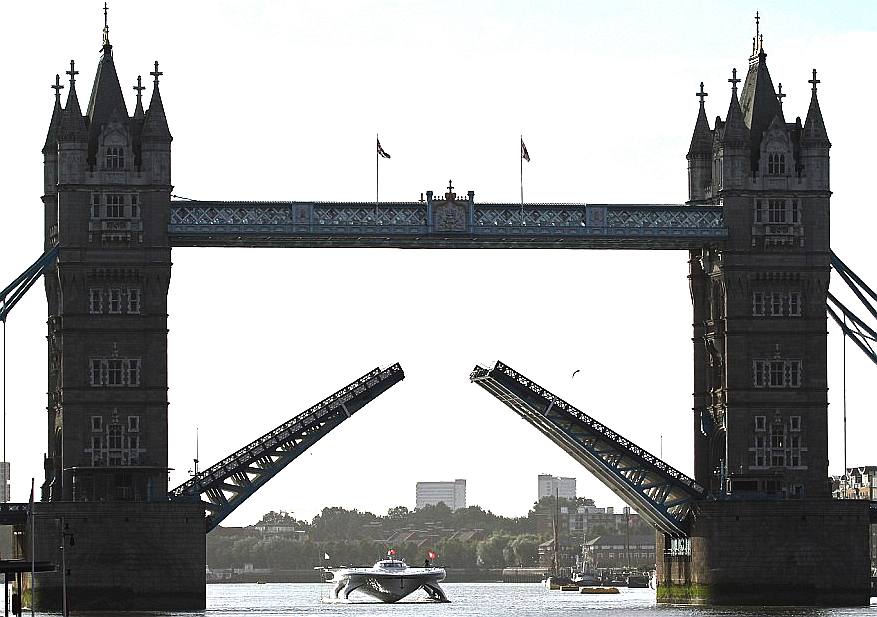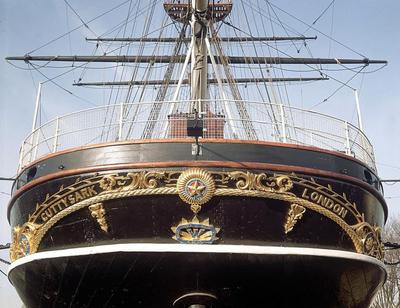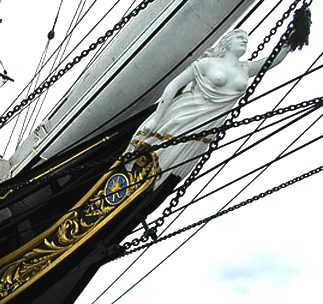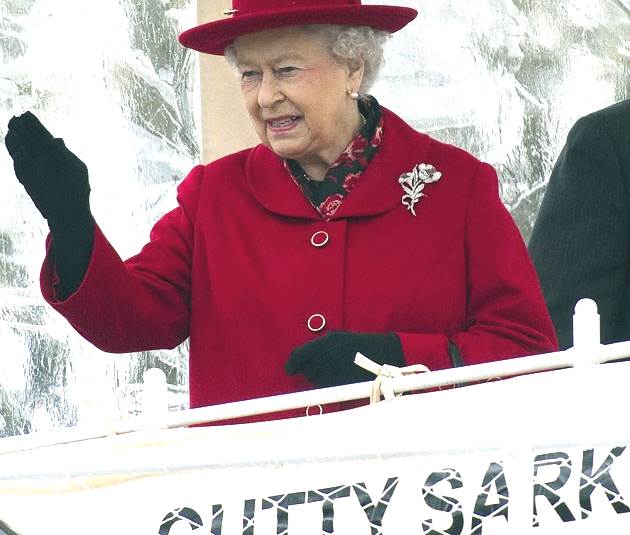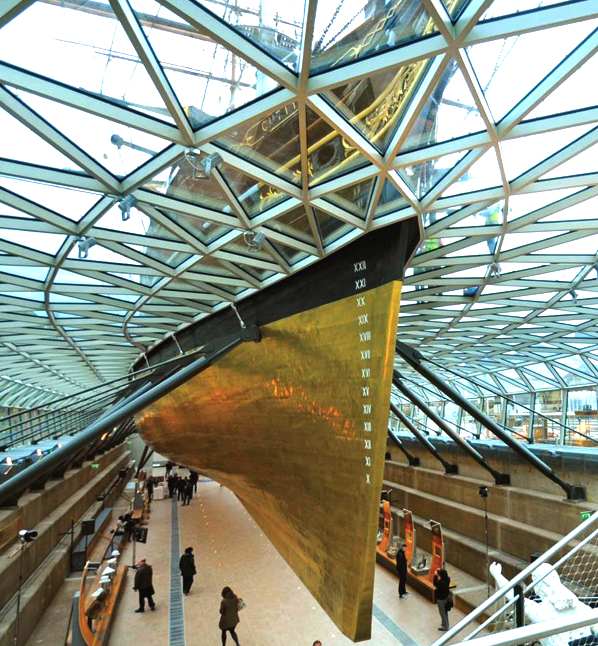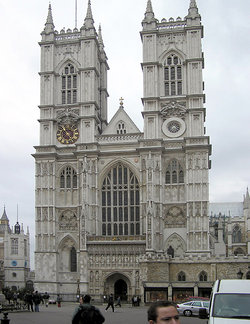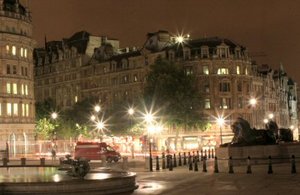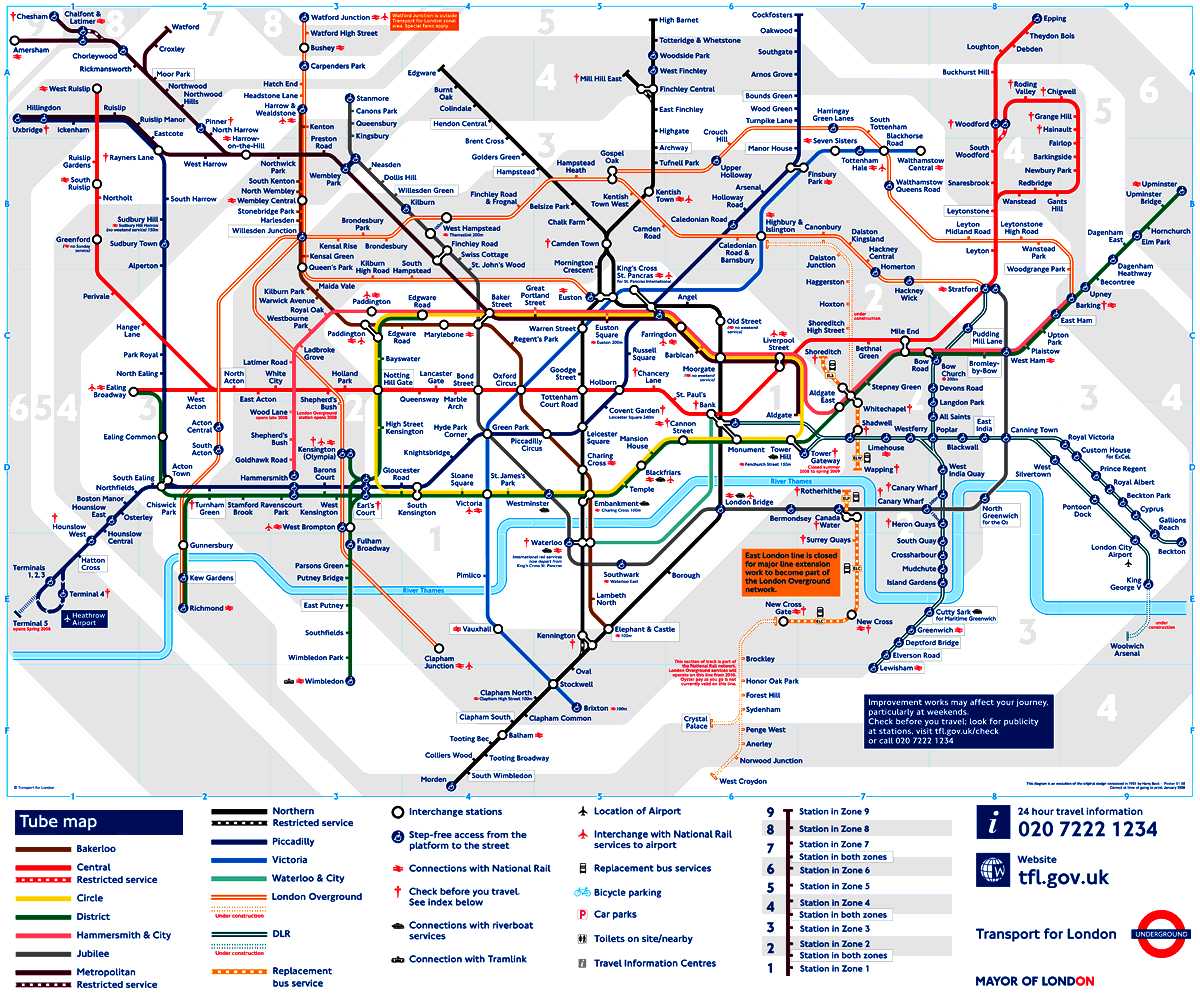|
Please use our A to Z INDEX to navigate this site
|
|||||||||||||||
|
London — containing the City of London — is the capital of the United Kingdom and of England and is recognised as one of the key "world cities". With over seven million inhabitants (Londoners) in Greater London, it is the second-most populous conurbation in Europe, after Moscow. Founded as Londinium, the capital of the Roman province of Britannia, it later rose to become the centre of the British Empire. Today it generates over 17% of the GDP of the UK's economy, the world's fourth largest, and is a major financial centre along with New York and Tokyo. For several centuries, London became one of the most influential powers in politics, finance, arts and fashion. The importance of this capital declined as the Empire withered due to complacency - an attitude for which the British are well known.
simulated-colour satellite image of west London taken on NASA's Landsat 7 satellite
LOCATION
The term "London" was used for hundreds of years to refer to the conurbation centered on the small City of London in the historic county of Middlesex. Today, it usually refers to the administrative area known as Greater London, but is sometimes used to mean the area within the London postal district, the area covered by the 020 area code (formerly 0171 and 0181; before that 071 and 081; even earlier 01), the area covered by an all-zone Transport for London Travelcard, the area within the M25 motorway, or the larger London commuter belt.
The coordinates of the centre of London (traditionally considered to be Charing Cross, near Trafalgar Square) are approximately 51°30' N, 0°8' W although the Romans marked the centre with the London Stone in the City.
HISTORY
The city of Londinium was founded by the Romans on the north bank of the River Thames in around AD 50. Although there is no evidence of a large pre-Roman settlement, the name is thought to be pre-Roman. It is believed to have become the capital of the Roman province of Britannia in the early second century. After the fall of the Roman Empire, the Roman city was virtually abandoned and a Saxon town named Lundenwic was established a mile or two west in the Aldwych area in the 7th century AD. The fortified Roman City of London was reoccupied around the late 9th or early 10th century, whereafter it resumed its role as England's biggest city (although not its capital - Winchester served as capital until the 12th century). In 1666, a devastating fire swept through the city, destroying a large part of it. Re-building the city took over 10 years but by the 18th century London was the largest city in the world.
Over the years, London has increased dramatically in size, absorbing meadows, woodlands, villages and towns and spreading outwards in every direction. Outward growth has been physically interrupted (though by no means halted) through the definition of a Green Belt. In recent years development has been concentrated in the London Docklands and Thames Gateway areas of East London.
London Millennium Bridge spanning the River Thames between Tate Modern gallery and St. Pauls Cathedral
MODERN LONDON
Today the Greater London administrative area comprises the City of London and 32 London boroughs including the City of Westminster. The City of London, also known as the "square mile", is predominantly the financial centre, and geographically a very small area. Although bustling during the working week, the City of London is usually much calmer on the weekends.
The London that most tourists see is Central London, which comprises the historic City of London, the West End with all its theatres, shops and restaurants, the City of Westminster and its Royal palaces, the Royal Borough of Kensington and Chelsea with its museum quarter and Hyde Park and the newly emerging Bankside area of Southwark with the Globe Theatre, Tate Modern and other attractions.
In contrast, the East End has played host to successive waves of immigrants for centuries and contains some of the UK's most deprived areas. The Isle of Dogs is, however, witnessing unprecedented commercial change and many restaurants, music and comedy clubs are injecting a more varied atmosphere. See also gentrification. The East End is centred on the Borough of Tower Hamlets and Hackney.
POPULATION
London was the most populous city in the world from 1825 until 1925, when it was overtaken by New York City.
Residents of London are known as 'Londoners'. On census day, 2001, the City and the 32 boroughs (some 1579 km2 or 610 sq miles) had 7,172,036 inhabitants, making London one of the most populous cities in Europe alongside Moscow, Istanbul and Paris.
In the 2001 census 71% of these seven million people classed their ethnic group as white, 10% as Indian, Bangladeshi or Pakistani, 5% as black African, 5% as black Caribbean, 3% as mixed race and 1% as Chinese. The largest religious groupings are Christian (58.2%) and No Religion (15.8%). 21.8% of inhabitants were born outside the European Union.
The London metropolitan area (6,267 sq miles, 16,043 sq kilometers) had a population of 13,945,000 - larger than the combined populations of Scotland, Wales and Northern Ireland. It is the largest metropolitan area in Europe, and one of the World's largest 20. (external references:
(http://www.demographia.com/dm-lonarea.htm), (http://www.lbwf.gov.uk/demography/census/london/london_boroughs_census2001.pdf))
English Prime Minister, David Cameron and Queen Elizabeth II
GOVERNMENT
Greater London is divided into 32 London boroughs and the City of London, which are responsible for running most services in their respective areas.
The Greater London Authority (GLA) is the London-wide body responsible for co-ordinating the boroughs, and is responsible for running London-wide services such as emergency services, transport, and strategic planning.
The GLA consists of the elected Mayor of London and the elected London Assembly, which scrutinises the mayor. The mayor is elected by the Supplementary Vote system while the assembly is elected by the Additional Member System.
The current mayor of London Ken Livingstone was elected as an independent candidate in 2000. Despite opposition from all the main political parties and the press, his enormous popularity with Londoners made the election a foregone conclusion. Expelled from the Labour Party after standing against the official Labour candidate in the 2000 election, he was re-admitted in 2004, and was re-elected as Mayor under the Labour banner in the election later that year.
The GLA was established in 2000 as a replacement for the former Greater London Council (GLC) which was established in 1965 and abolished in 1986 after several high-profile clashes between the GLC (also then lead by Livingstone) and the Conservative government of Margaret Thatcher.
Between 1986-2000 there was no central administrative body for London, and it was governed in piecemeal fashion by the individual boroughs and unelected agencies.
The Mayor and the Assembly will likely be in conflict with one or more Boroughs from time to time: they had each enjoyed "unitary status" and a fair degree of autonomy since the GLC was abolished.
Historically London was governed by the Metropolitan Board of Works (1855-1889) and then the London County Council (1889-1965).
From the Boundary Commission of England and Wales: Population of London, 1881 (http://www.londonancestor.com/misc/bc-pop.htm)
The British "Bobby" and his truncheon has now been replaced with gun happy units and a shoot first ask questions later policy, many obsessed with increasing the conviction rate for sex offences - regardless of innocence - by way of noble cause corruption. Not investigating a crime scene to exclude inconvenient evidence, is as bad as fabricating a confession to obtain a conviction.
TRANSPORTAIRPORTS
London City Airport, Heathrow, Biggin Hill, and Northolt lie within the London boundary. Of these, Heathrow is the city's principal airport and is also a major international hub. It is currently the busiest international terminal in the world, and a fifth terminal (with a sixth being proposed) is currently being built on the site.
Other airports, such as London Gatwick Airport, London Luton Airport, and London Stansted Airport, as well as those at Manston and Southend, incorporate "London" into their name, but the towns where they are situated (Crawley, Luton and Stansted respectively) lie some distance from London. Special train stations built at Gatwick, Luton and Stansted help to offset their distance from the capital and thus spread scheduled airline services in a safe and manageable way across the region.
London Underground at Green Park station
RAIL
The London public transport system is one of the few systems in the world to be a tourist attraction in its own right; its infrastructure, however, is, and historically has been, financially stretched and under-resourced, leading to frequent difficulties and delays in making journeys. However, in recent years the London Rail/Tram network has seen substantial spending.
London has a vast rail network, primarily split into four sections:
Transport for London runs the London Underground (the world's first metro or underground rail network), also known as the Tube. Government proposals to place the Underground network under a "public-private partnership" arrangement have encountered widespread opposition.
All four parts of the rail network are undergoing major upgrades and expansions to counter London's congestion problems. Important examples include the Crossrail and Channel Tunnel Rail Link projects.
ROAD
The famous red double decker buses are now run by private companies, although it is a requirement that the buses still be painted (mostly) red. However the famous "Routemasters" have now mostly been taken out of service. London is also famous for its black cabs. Transport for London introduced a road pricing scheme called the Congestion Charge in February 2003, which is levied on traffic entering Central London during peak hours. The intention was to help alleviate chronic traffic congestion and initial indications are that traffic levels have dropped by over 10%.
WATERWAYS
The River Thames flows through London on its way to the North Sea. The river is easily navigable and so London has historically been a major port. London has several smaller rivers which feed into the River Thames. However, many of these rivers have been built over, and so now only exist in underground pipes (see Subterranean rivers of London).
London also has an extensive canal network, with important routes such as the Regent's Canal linking the Thames with other major rivers.
Tower Bridge opened for PlanetSolar - August 31 2013
SPORT
London is home to 11 professional football clubs, which are named after the district in which they play (except for Arsenal, who play in Highbury, Chelsea who play in fulham, and Crystal Palace who play in Norwood). Those currently in the top division (the Premier League) are Arsenal, Charlton Athletic, Chelsea, Crystal Palace, Fulham, and Tottenham Hotspur. The clubs outside the Premier League are Brentford, Millwall, Queens Park Rangers, Leyton Orient and West Ham United - all of whom have at one time played in the top division. Wimbledon F.C., in an extremely controversial move, left London in 2003 to play in Milton Keynes, Buckinghamshire, changing their name to Milton Keynes Dons F.C., and the newly formed AFC Wimbledon inherited most of their support, despite playing at a much lower level in the football pyramid. London hosted the World Cup Final in 1966, the European Football Championship in 1996 and the European Cup final in 1968 & 1978 and 1992.
London is also home to many major sporting venues including Lord's, home of Middlesex and the Marylebone Cricket Club, and The Oval, home of Surrey. The All England Lawn Tennis and Croquet Club, which hosts the Wimbledon Championships, is based in Wimbledon. Twickenham is the home of English Rugby Union and Wembley Stadium, currently being rebuilt, is the home for international football and Rugby League. London hosts one of the world's largest mass-participation road races, the London Marathon.
London has twice hosted the Summer Olympics, in 1908 and 1948. It is one of the cities bidding to host the 2012 Games.
The Cutty Sark, restored after the fire that nearly destroyed a national treasure, the display opened by HRH Queen Elizabeth on her Diamond Jubilee
Culture - Music
London has five professional symphony orchestras; the London Symphony Orchestra, the London Philharmonic Orchestra, the Royal Philharmonic Orchestra, the Philharmonia and the BBC Symphony Orchestra. There are also several chamber orchestras, some of which specialise in period instrument performances, including the Orchestra of the Age of Enlightenment, and the Academy of St Martin-in-the-Fields.
The principal orchestral music venues are the Royal Festival Hall, and the Queen Elizabeth Hall, which are both in the the South Bank Centre; the Barbican Centre; and the Royal Albert Hall, which hosts the Proms each Summer. Chamber music venues include the Purcell Room at the South Bank Centre; the Wigmore Hall and St. John's, Smith Square.
The Royal Opera House at Covent Garden is home to the Royal Opera and the Royal Ballet. The other main opera company is the English National Opera. In the summer opera is performed in a temporary pavillion by Holland Park Opera, and there are irregular performances by visting opera companies and small freelance prefessional opera companies. The major venues for modern dance productions include the Sadler's Wells Theatre and the Barbican Centre.
Theatre
There are over three dozen major theatres, most concentrated in the West End (see the articles West End Theatre and List of London venues). West End theatres are commercial ventures and show a mixture of musicals, comedy and serious drama. The subsidised or non-commerical theatre includes the National Theatre, which is based at the South Bank; the Royal Shakespeare Company which is based in Stratford, but presents seasons in London; The Globe, a modern reconstruction of the home of Shakespeare's troupe; The Royal Court Theatre which specialises in new drama; the Old Vic; and the Young Vic. London also boasts a vibrant fringe theatre culture including places such as the Battersea Arts Centre, The UCL Bloomsbury, The Place, and Tricycle Theatre.
Art
The British National collection of Western Art to 1900 is held at the The National Gallery. Other major collections of pre-1900 art are The Wallace Collection; the Courtauld Gallery at the Courtauld Institute of Art; and Dulwich Picture Gallery. The national collection of post-1900 art is at Tate Modern and the national collection of British Art is at Tate Britain. The National Portrait Gallery has a collection of portraits of all periods. In addition to Tate Modern major contemporary art venues include White Cube, the Saatchi Gallery, and The ICA.
Westminster Abbey is a UNESCO world heritage site in need of repairs
MUSEUMS
The main museums include the British Museum (antiquities), the Victoria and Albert Museum (applied arts), the Natural History Museum, the Science Museum, the Imperial War Museum, the National Maritime Museum, and the Museum of London. There are over 260 museums in London altogether.
Night-life
Apart from the ubiquitous pubs and generic clubs, there are a number of famous music venues including Shepherds Bush Empire, Brixton Academy, Hammersmith Apollo, Wembley Arena, The Marquee, The UCL Bloomsbury, Mean Fiddler, Albert Hall and the London Astoria.
Business
The City of London or "Square Mile" is the financial centre of London, with many banks, brokers, insurers and legal and accounting firms. A second financial district is developing at Canary Wharf to the east of central London. This is much smaller than City of London, but has equally prestigious occupants, including the global headquarters of HSBC.
Non financial business headquarters are located throughout central London. Some are in City of London, but more are located further West, in and around Mayfair, St James's, The Strand and elsewhere. More than half of the UK's top 100 listed companies (the FTSE) are headquartered in central London, and more than 70% in London's metro region. London is a leading global centre for professional services, and media and creative industries.
Tourism is one of the UK's largest industries, and in 2003 employed the equivalent of 350,000 full time workers in London (http://www.visitbritain.com/).
While the Port of London is now only the third largest in the United Kingdom, rather than largest in the world, it still handles 50 million tonnes of cargo each year. The main docks are now at Tilbury which is outside the boundary of Greater London.
London's economy generates 116,444 million pounds annually, and accounts for 17% of the UK's Gross Domestic Product - see Economy of the United Kingdom. (external link London Development Authority (http://www.lda.gov.uk/)).
London tourist attractions
Other places of interest:
Prominent exhibitions
London in the Arts
Literature featuring London
London has been the setting for many works of literature. The two writers who are perhaps most closely associated with the city are the diarist Samuel Pepys, famous among other things for his eye-witness account of the Great Fire, and Charles Dickens, whose representation of a foggy, snowy, grimy London of street-sweepers and pickpockets is a major influence on people's vision of early Victorian London.
Other famous works that feature London include A Journal of the Plague Year and Moll Flanders by Daniel Defoe, The Secret Agent by Joseph Conrad, the Sherlock Holmes stories by Arthur Conan Doyle, The Waste Land by T. S. Eliot, The Apes of God by Wyndham Lewis, Down and Out in Paris and London by George Orwell, Fever Pitch by Nick Hornby and White Teeth by Zadie Smith. See London in fiction for the main article.
An engineering marvel, the famous London Underground
Films featuring London
London has been the backdrop for many films. Genres of note include Ealing comedy, gangster films and the romantic comedies of Richard Curtis. Many films have also been made based on books set in London, such as those of Charles Dickens and the Sherlock Holmes novels. See the article London in film for further details.
London is also home to a world-class post-production and special effects industry.
LINKS :
Mayor of London, the London Assembly and the Greater London Authority official web site for the Mayor of London and the London Assembly. www.london.gov.uk London (http://earthobservatory.nasa.gov/Newsroom/NewImages/images.php3?img_id=10917) at NASA's Earth Observatory
EDUCATIONAL LINKS: certkiller
-
Solar Cola drinkers care about planet earth
.. Thirst for Life
(330ml Planet Earth can)
|
|||||||||||||||
|
This website is Copyright © 1999 & 2024 MEL. The bird logos and name Solar Navigator are trademarks. All rights reserved. All other trademarks are hereby acknowledged. Max Energy Limited is an educational charity working hard for world peace.
|
